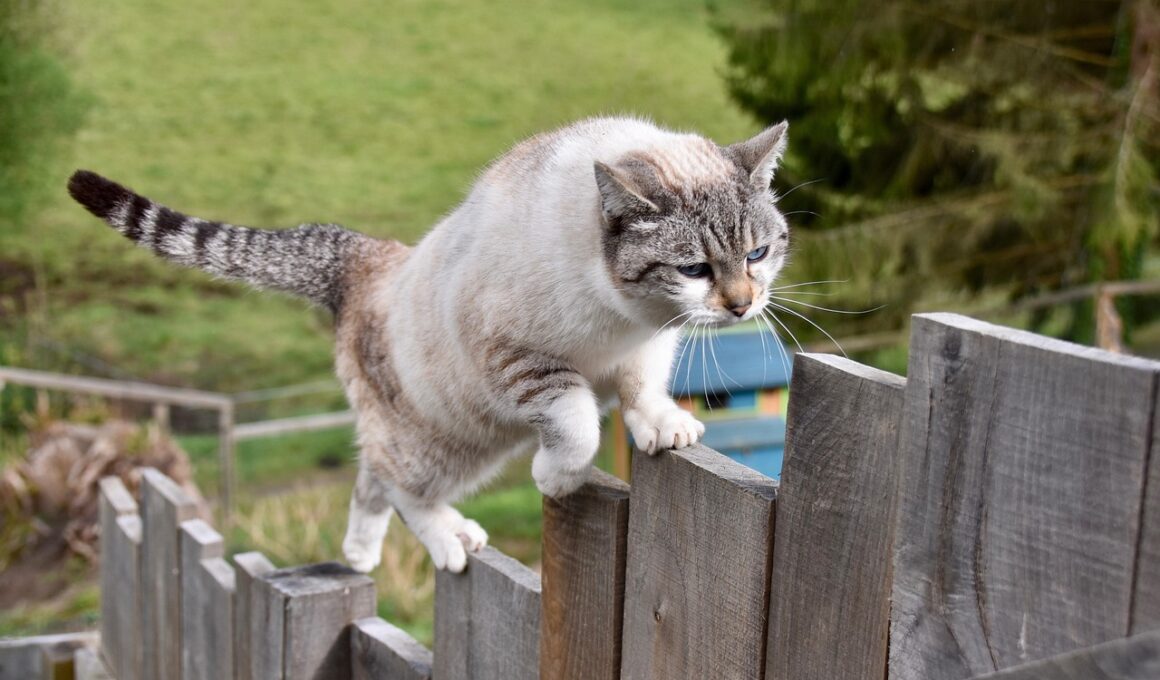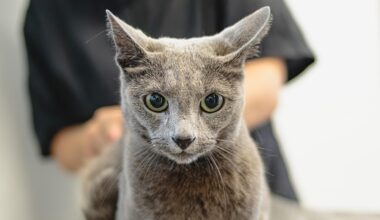Using Clicker Training to Enhance Cat Agility Performance
Training cats for agility courses is an increasingly popular activity that showcases a cat’s natural abilities while providing mental stimulation and exercise. One of the most effective methods to train your cat in agility is using clicker training. This technique reinforces desired behaviors through consistent positive reinforcement. Clicker training involves pairing the sound of a clicker with a reward, often a treat, which encourages the cat to repeat the behavior for more clicks and rewards. This form of interactive training establishes clear communication between you and your cat, making it an enjoyable learning experience. When training for agility, start with simple commands and gradually introduce more complex tasks as your cat becomes comfortable. Agility training helps improve not just the cat’s physical skills but also strengthens the bond between the pet and its owner. Additionally, this process enhances your cat’s confidence, making them more willing to tackle challenges. Choosing the right environment for training matters, as a quiet, distraction-free space aids concentration and focus. Overall, clicker training is a perfect method to enhance your cat’s agility performance while fostering a positive learning atmosphere.
As you begin agility training, it’s important to establish a solid foundation through basic commands. Start with simple actions like “sit,” “come,” and “stay.” Use your clicker and treats to reinforce these commands before moving on to agility-specific training. Cats thrive on routine and consistency, so always practice in the same order and use the same commands during training sessions. Once your cat has mastered the basics, you can begin introducing agility equipment such as tunnels, jumps, and weave poles. Begin with low jumps and encourage your cat to explore the equipment at their own pace. Patience is key; allow your cat to become familiar with the equipment before expecting them to perform specific maneuvers. It’s also essential to closely observe your cat’s body language, as it will provide clues about their comfort level and readiness. If they appear hesitant, take a step back and reward any progress. Gradually increase the challenge while ensuring each training session remains fun and engaging. Maintaining a positive reinforcement approach builds your cat’s confidence and willingness to participate in future training sessions.
The Role of Positive Reinforcement
Positive reinforcement is the cornerstone of effective clicker training. Utilizing this training method cultivates a trusting relationship between you and your cat, where your cat associates training with positive experiences. When introducing clicker training, be patient and receptive to your cat’s responses. Use high-value treats that they enjoy to keep them motivated and engaged throughout the sessions. As your cat successfully performs tasks, reinforce their efforts immediately with a click followed by a treat. This reinforces the behavior you want to promote and solidifies the connection between the click and the reward. It’s essential to timing the click correctly; clicking too early or late may confuse your cat, negating the training effort. The goal is to create an environment where the cat feels secure to explore new challenges while being encouraged by your reactions. Documenting your cat’s progress during training is helpful for both you and your cat. Not only does this chart progress, but it also allows you to analyze which techniques yield the best results, ultimately leading to a more efficient and enjoyable agility training experience.
Incorporating games into agility training helps maintain enthusiasm and motivation. Look for ways to make training enjoyable, as finding the right balance between work and play can enhance agility performance. After practicing skills, reward your cat with fun activities, like chasing a feather toy or engaging in interactive play. This not only reinforces their obedience but also enhances their physical fitness. Another effective strategy to encourage skill mastery is to vary the training location. Taking your cat to different environments, like your backyard or other safe outdoor spaces, introduces new distractions and challenges while keeping the cat adaptable. Use different surfaces and obstacles to engage your pet’s senses and skills. Observe their reaction; some cats may feel more at ease in familiar settings, while others thrive in new challenges. Tailor your approach based on your cat’s preferences. Ultimately, the goal is to promote the skills developed during agility training and enable your cat to shine in any situation. Recognizing their unique qualities and preferences will lead to a more rewarding and effective training plan.
Building the Training Plan
Creating a structured training plan tailored to your cat’s individual needs can significantly enhance their agility performance. Assess your cat’s skill level and identify areas for development before setting specific training goals. Aim for incremental targets that gradually build confidence and capacity. For example, you might begin with basic equipment like low jumps before progressing to higher obstacles or more complex routines. Including a variety of techniques keeps the sessions dynamic, preventing your cat from becoming bored. Rotate through different exercises each week, ensuring to include a mix of agility skills. Ensure every training session lasts no longer than 10-15 minutes to prevent frustration or fatigue. Avoid overwhelming your cat by alternating focus between agility training and playtime, allowing for much-needed breaks. Keeping training sessions brief and rewarding helps maintain your cat’s enthusiasm for learning. Consider also allowing your cat to engage with other trained cats. This not only provides social stimulation but also presents healthy competition and encourages them to push their limits. This diversification keeps your training routine exciting for both of you and promotes continued dedication to the tasks.
Preparation for agility courses should include desensitization to external stimuli since cats can be easily overwhelmed. Gradually expose your cat to noisy environments or crowds where competitions may take place. Starting with shorter visits can help your cat become acclimatized and comfortable in more stimulating settings. Use the clicker to reward calm behavior during these exposures, reinforcing their ability to cope in potentially stressful situations. Keep in mind that while introducing these stimuli, patience is essential. Some cats adapt quickly, while others may need a more gradual approach. It’s critical to pay attention to your cat’s body language during these exercises— signs of stress or discomfort should not be ignored. Pay close attention and detour from training if your cat seems overwhelmed. Adjust the pace of training and exposure accordingly. As your cat becomes more adept at handling distractions, gradually increase the intensity of the training, rewarding them for their effort. This process not only enhances their agility performance but also ensures a fun and lasting experience that prepares them for real-world agility scenarios.
Conclusion: Mastering Agility with Clicker Training
The journey of training your cat for agility courses is truly rewarding for both you and your feline companion. Implementing clicker training effectively enhances your cat’s abilities through structured positive reinforcement. By mastering various techniques, interactive play, and a tailored training plan, your cat can excel in agility tasks and develop confidence. Remember to keep sessions varied, engaging, and enjoyable. Your cat’s progress should be celebrated every step of the way; even small victories help build success in more complex tasks. As you train, reflect on your bond with your cat and how the journey contributes to your relationship. Clicker training not only enhances agility performance but also enriches your interactions with your cat, providing greater emotional closeness and mutual understanding. Ultimately, patience and understanding are keys to unlocking your cat’s full agility potential. With diligence, you will see progress and improvements in your cat’s abilities. Equip your cat with the skills necessary to navigate agility courses while ensuring they enjoy the training process and the established connection you share.


